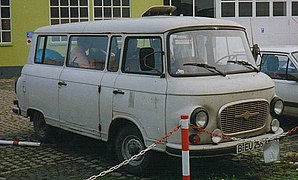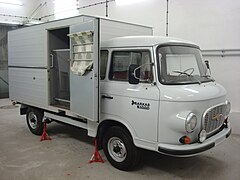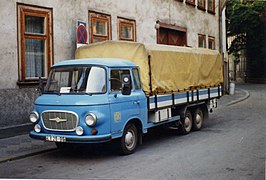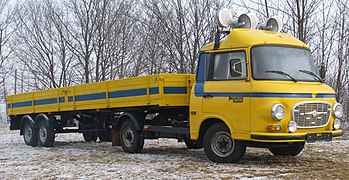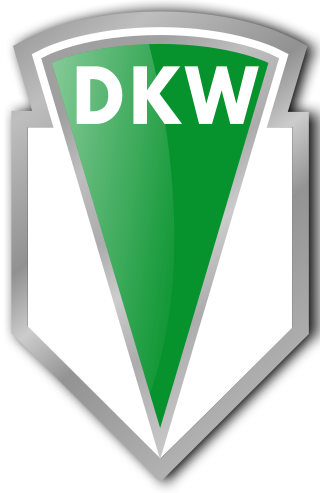
DKW was a German car- and motorcycle-marque. DKW was one of the four companies that formed Auto Union in 1932 and thus became an ancestor of the modern-day Audi company.
Trabant is a series of small cars produced from 1957 until 1991 by former East German car manufacturer VEB Sachsenring Automobilwerke Zwickau. Four models were made: the Trabant 500, Trabant 600, Trabant 601, and the Trabant 1.1. The first model, the 500, was a relatively modern car when it was introduced.

Auto Union AG, was an amalgamation of four German automobile manufacturers, founded in 1932 and established in 1936 in Chemnitz, Saxony. It is the immediate predecessor of Audi as it is known today.

The Volkswagen Type 2, known officially as the Transporter, Kombi or Microbus, or, informally, as the Bus (US), Camper (UK) or Bulli (Germany), is a forward control light commercial vehicle introduced in 1950 by the German automaker Volkswagen as its second car model. Following – and initially deriving from – Volkswagen's first model, the Type 1 (Beetle), it was given the factory designation Type 2.

The Volkswagen Caddy is a panel van and leisure activity vehicle (M-segment) produced by the German automaker Volkswagen Group since 1980. It is sold in Europe and in other markets around the world. The Volkswagen Caddy was first introduced in North America in 1980 and in Europe in 1982. The first and second generations also had pick-up variants.
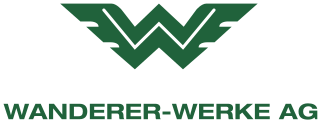
Wanderer was a German manufacturer of bicycles, motorcycles, automobiles, vans and other machinery. Established as Winklhofer & Jaenicke in 1896 by Johann Baptist Winklhofer and Richard Adolf Jaenicke, the company used the Wanderer brand name from 1911, making civilian automobiles until 1941 and military vehicles until 1945.

Horch was a car brand manufacturer, founded in Germany by August Horch & Cie at the beginning of the 20th century.
The Mercedes-Benz MB100 is a light commercial cabover van (M) made by Mercedes-Benz España S.A. from 1981 to 1996 at their Vitoria-Gasteiz factory in northern Spain. The third generation model was manufactured by SsangYong alongside the rebadged SsangYong version from 1995 to December 2003 in South Korea, with another rebadged variant manufactured by Maxus of SAIC Motor from 2009 to 2014 in China.
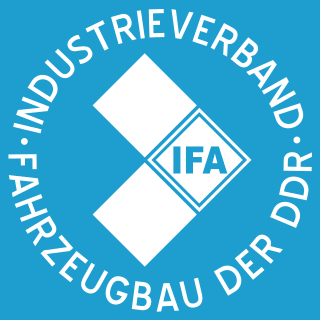
Industrieverband Fahrzeugbau, usually abbreviated as IFA, was a conglomerate and a union of companies for vehicle construction in the former East Germany.

The Volkswagen Crafter, introduced in 2006, is the largest three- to five-ton van produced and sold by the German automaker Volkswagen Commercial Vehicles. The Crafter officially replaced the Volkswagen Transporter LT that was launched in 1975, although it is known as the LT3, its production plant code.

The DKW F102 is a passenger car that was produced from August 1963 by the German manufacturer Auto Union. Superseding the Auto Union 1000, it was the last model branded as a DKW by the manufacturer and also the last West German production car equipped with a two-stroke engine.

Tempo, was a German automobile manufacturer based in Hamburg. The company was founded by Oscar Vidal in 1924.

The Auto Union 1000 is a luxury compact front-wheel drive automobile manufactured by Auto Union GmbH between 1958 and 1969. It was the first model branded as an Auto Union by the manufacturer since the 1930s; it replaced the DKW 3=6, although the latter continued in production, until the end of 1959. The two cars were broadly similar, but the new car had its two-stroke engine enlarged to 981 cc yielding a 10% - 37% power increase.

The DKW F8 is a compact front-wheel drive two-stroke engined saloon, introduced in 1939. The F8 was slightly shorter than its predecessor despite having a marginally increased wheelbase. The base model, known as the Reichsklasse, was manufactured only till 1940 but the Meisterklasse sedan continued in production until 1942. In addition to the saloons, cabriolet versions were offered.

The automotive industry in Germany is one of the largest employers in the world, with a labor force of over 857,336 (2016) working in the industry.
Framo was a minivan, motor tricycle and car manufacturer in Saxony, Germany. It was established by Danish engineer Jørgen Skafte Rasmussen, the founder of DKW, in 1923. Framo became the core of the Barkas minivan manufacturer in 1957.

The Trabant 601 was a Trabant model produced by VEB Sachsenring in Zwickau, Saxony. It was the third generation of the model, built for the longest production time, from 1964 to 1990. As a result, it is the best-known Trabant model and often referred to simply as "the Trabant" or "the Trabi". During this long production run, 2,818,547 Trabant 601s were produced overall and it was the most common vehicle in former East Germany.
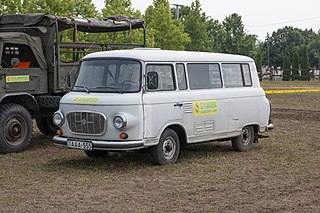
The Barkas B 1000 is a forward control panel van made by the East German manufacturer VEB Barkas-Werke in Chemnitz. It was made in several different body styles: as a panel van, minibus seating eight, and pickup truck. Special-purpose vehicles based on the Barkas B 1000 were made as well. In June 1961, the production of the four-door panel van commenced, with the minibus following in spring 1964, and the pickup truck in spring 1965. With its payload of 1,000 kg, and its spacious interior, the Barkas B 1000 proved to be very durable and reliable. During its 27-year production period, it received some minor updates in 1963 and 1972, but all efforts to develop a successor failed, and there were no major design alterations for the remainder of its production. The successor Barkas B 1000-1, introduced in autumn 1989, carried over the technical design, but it was fitted with a different engine. In 1990, manufacture was sold to a Russian company, but production never was restarted.

The Mercedes-Benz N1300 is a light commercial vehicle designed and manufactured by the Spanish subsidiary IMOSA based in Vitoria-Gasteiz, in the Basque Country, north of Spain. Its body had its roots in the Fissore-designed DKW F1000 L van of 1963.

The Barkas V 901/2 is a light commercial lorry made by the East-German manufacturer VEB Barkas-Werke, Hainichen in Karl-Marx-Stadt (Chemnitz) from 1954 until 1961. Originally, the vehicle was called the IFA V 901/2; this name was changed to Barkas V 901/2 in 1957. The V 901/2 is a body-on-frame vehicle with a front engine, and rear-wheel drive, that was available in several different body styles, including pickup trucks, minibusses, and panel vans. It succeeded the IFA Framo V 901, and was itself succeeded by the Barkas B 1000.




